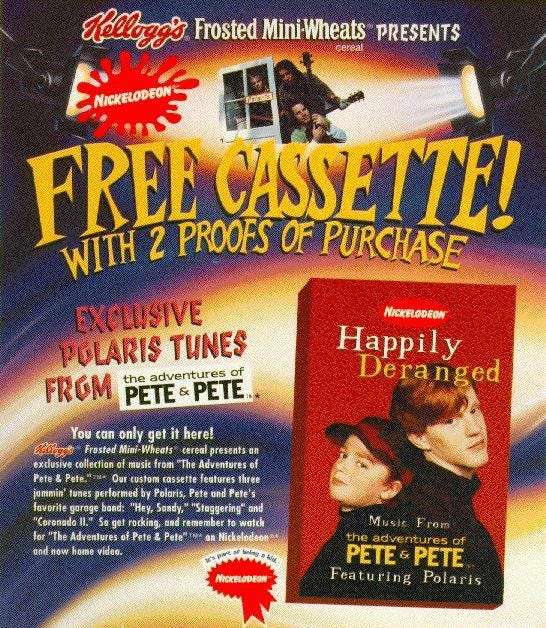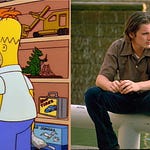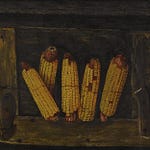The eighth episode of the Nickelodeon show The Adventures of Pete and Pete is about the younger of the show’s titular Petes trying to track down a song. He first hears this song from a band playing in a local garage. He sings it to himself until the memory starts to fade. He hums the melody over his makeshift radio station to find anyone else who has heard it. When no one responds, he starts a band to rewrite it.
This episode sent hundreds of kids down a similar path. I was one of them.
It wasn’t just one song. Almost every episode of Pete and Pete had music that grabbed my attention. There was a tune that played under the closing credits of one episode that sounded like robots strumming rubber bands and banging on toy drums, with lyrics about saying “goodnight” but meaning “goodbye.” It haunted me.
And, of course, there was the opening theme, by the same band that hypnotized Little Pete.
To a nine-year-old in 1994 who was just beginning to love music, Pete and Pete presented rock and roll as something less polished, less expensive, and more accessible than most of what I saw on the rock videos on MTV (a network owned by Nickelodeon’s parent company Viacom). The shots of three guys in street clothes playing on a front lawn while a sprinkler sprays and kids ramp their bikes made rock music seem like something anyone could play … even a nine-year-old. I sat by the TV when the show started and tried to copy the band’s hand movements on an entry-level electric guitar we had in the house.
It’s important to have levelers like this in art—they bring in new people and ideas. Someone will always scoff at the abstract, untrained, or overtly populist. But no movement or style can truly reach the masses if the masses can’t relate to it. When people relate to art, some of them will think they can make it. And their efforts push art further. To look specifically at music, think of the creative blossoming that has come from lots of young people getting access to inspiration and equipment. The world of music has been made better by the transcriptions of folk songs in Sing Out magazine, the Kingsmen’s brutish recording of “Louie Louie,” affordable Sears Silvertone electric guitars, and free downloadable beat-making software. In a documentary on his band, John Flansburgh of the new-wave art rock group They Might Be Giants said that until punk rock came along, saying you could be in a rock band in the mid-1970s was like saying you could be The Incredible Hulk: technically impossible and laughably lofty.
Pete and Pete’s rock populism was rooted in the indie scene of the late ‘80s and early ‘90s. Michael Stipe made an appearance in the show. So did Debbie Harry, Juliana Hatfield, and Gordan Gano. Iggy Pop and Syd Straw had recurring roles. And creators Will McRobb and Chris Viscardi showed their interest in pop culture—both mainstream and obscure—throughout the series, booking guest roles for LL Cool J, Patty Hearst, Chris Elliot, Janeane Garofalo, and Ellen Cleghorne.
This was before the trend of casting celebrities in kids’ movies and shows as jokes for parents. When Ozzy Osbourne shows up in Trolls: World Tour, he plays the aged king of rock trolls. It’s a joke that only works for people who know who Ozzy is. When Kate Pierson from the B-52s appears in Pete and Pete, she plays a mysterious neighbor who was once married to a masked ice cream man. Her career outside of the show has no bearing on her character. She’s there because she’s cool. Her coolness comes through on the screen even if you don't know who she is. Pete and Pete embodied the no-parents-allowed attitude that Nickelodeon shows had at the time. It’s surreal and strange in the way a kid’s imagination can be. Adults are another species.
The most frequent musical cameo on Pete and Pete is the band behind the theme song, which is the same band Little Pete becomes obsessed with. They’re called Polaris, but are truly three-fourths of Miracle Legion, a band that was (usually unfairly) described as New England’s answer to R.E.M.
In 1994, I had no way of knowing this. I also had no way of hearing the music from the show outside of the broadcast, which Nickelodeon changed at a rate that implied they didn’t want anyone to see anything on purpose.
The best chance to catch Pete and Pete was on Nick in the Afternoon, a summertime programming block that took requests and answered viewer letters. It was hosted by a popsicle stick puppet named Stick Stickly. One day, a kid wrote in with a question about the music on Pete and Pete. The band is called Polaris, Stick answered, adding that the singer was named Muggy. This information was interesting, but useless to me in my quest to hear this music in something other than short bursts on cable TV.
Sometime in 1995, I sat down for a bowl of Frosted Mini-Wheats and saw Muggy’s face on the back of the box. With two proofs of purchase, I could get a tape called Happily Deranged: Music from The Adventures of Pete and Pete featuring Polaris. I didn’t get the tape. This was an era of ordering by mail and waiting six-to-eight weeks for a package. That’s a lot of time to wait, especially for a kid. It’s possible I sent off and forgot about it. It’s also possible I decided it wasn’t worth the anticipation. Whatever the case, I regretted not having that tape whenever I caught an episode of Pete and Pete on TV.
Four years later, my brother showed me Napster, explaining that it could find me almost any song I wanted. I typed in “Polaris.” I found three songs credited to a band with that name: “Hey Sandy,” “Coronado II,” and “She Is Staggering.” After an excruciatingly long download, I played the tracks. They were lo-fi (they must’ve been ripped from the Happily Deranged cassette) but unmistakable. “Hey Sandy" was the theme song, which I had assumed was called “Happily Deranged.” The chorus-coated guitars of “She Is Staggering” had closed an episode of show that dealt with Big Pete and his best friend Ellen’s lingering crushes on each other.
I had come to think I would never hear this music again. If you didn’t capture something on a cassette or VHS, then it vanished after the broadcast. An entire era had been heard then forgotten. This led to a lot of mistaken memories and half-remembered realities—my mind combined scenes from different shows and melodies from different songs into one ongoing reel that could never be corrected and never be proven wrong. Until now.
Digital file sharing changed how my memory worked. At first it was Polaris, then it was old theme songs and tunes I partially remembered from hearing on the radio. These pieces of culture were no longer ephemeral. With the MP3s downloaded, my memories were updated, corrected, and yet somehow corrupted. I had recollections of riding somewhere in the back of my parents’ car, a particular song playing on the radio. Now I could hear the exact song. The contrast between hyper-accurate music and hazy memory was hard to handle. The song wasn’t as I remembered it. Maybe the experience wasn’t either.
Still, I kept listening.
Over time, other Polaris tracks landed on file sharing services. Soon, I learned the band had released a CD, which I called Border’s1 to request a hold on, and purchased the next time my parents were driving in that direction.
I listened to the album over and over. For a while, it was my favorite CD. I told friends about it, and most of them had the same reaction: “I remember that show had cool music.” With the CD and the internet, I was able to learn all about Polaris, Miracle Legion, and then the bands that played on Pete and Pete. The robots with rubber bands were The Magnetic Fields. The band at the school dance was Luscious Jackson. I filled in my knowledge of alternative music with the TV show as my north star. A world I barely remembered was coming into focus.
In 2015, on Record Store Day, I popped into a local shop and saw Music From The Adventures of Pete & Pete on vinyl. I bought it and took it home. I listened to it. I loved the songs, but something felt off.
It wasn’t anything to do with the music. The songs still meant a lot to me. I’m glad the band made money from my purchase of the record. I’m glad the singer, Muggy, real name Mark Mulcahy, kept making music after the show ended. His solo work is something to check out (especially the song “Bill Jocko”). Polaris has reunited and put out new music. More people making music and finding fans is great. But I hope all this is happening on the band’s terms.
The record felt like it was made on my terms. The music was written for a TV show, where it would be played for twenty seconds underneath dialogue and maybe a little more time behind credits. It was distributed on cassette tape through cereal boxes. It landed on CD, then vinyl. As inspired as the compositions were, their container was willed into existence for nostalgists with extra cash. The CD hit shelves once the initial audience for the show was old enough to buy it. The vinyl came 16 years later when that same audience was into collecting records. I felt like the dog that finally caught the car. But I hadn’t caught it by running. The car had come to me.
Or maybe other dogs had barked loudly enough to make the car stop. This is something men of my generation seem to do a lot. They gripe about Ghostbusters and blockbusters and ways that the people who made the things they love are “ruining their childhoods” by evolving and changing. They yell until they get what they want.
This is the opposite of the attitude Pete and Pete’s indie rock influence instilled in me. It’s the opposite of the spirit of creativity, in a lot of ways. There has always been and will always be fan service. There will always be pandering and there will always be perfect fits and there will always be people who confuse the two, or who expect the latter but insist on the former. But if a song reaches you, moves you, or inspires you, what more can you ask of it?
Where would that car have gone if I hadn’t chased it?
Art speaks to you. It doesn’t cater to you. Be grateful when it does anything for you at all. It might never do anything again.
Thank you for reading. If you think you know someone who might like this newsletter, please share it with them. I’d like to have more readers or listeners.
For another Border’s reference, please see last week’s newsletter.














